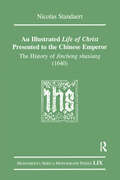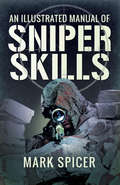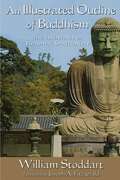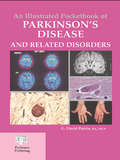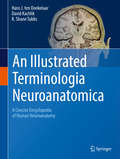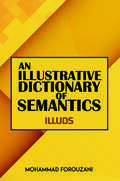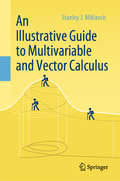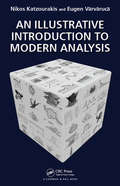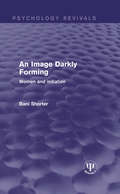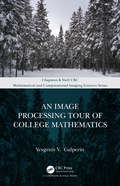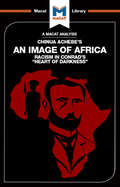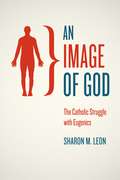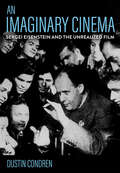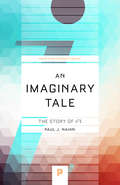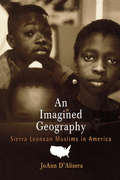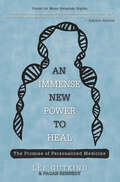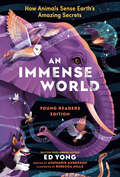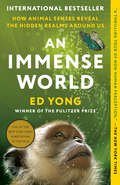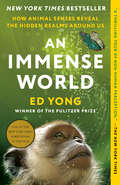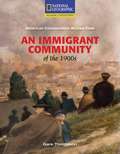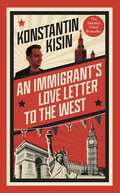- Table View
- List View
An Illustrated Journey: Inspiration From the Private Art Journals of Traveling Artists, Illustrators and Designers
by Danny GregoryTravel + Sketching = InspirationWhen we travel, we don't want to follow the same itinerary as everyone who's come before us. We want to feel like explorers, adventurers in undiscovered territory. And that's exactly what sketching can bring to the travel experience.An Illustrated Journey captures the world through the eyes of 40 talented artists, illustrators and designers. You'll experience the wonder of seeing familiar sights through a fresh lens but, more important, you'll be inspired to set pen to paper and capture your own vistas.The really wonderful thing about a sketchbook is that it can be totally private. You don't have to have an ounce of talent to enjoy learning how to really see what's in front of you. But lucky for us, the sketchbooks captured here are lovely, creative, intimate windows into each artist's mind.So, whether you're just returning to the art of drawing, abandoned by most of us after childhood, or you're looking for inspiration to take your illustration work in a new direction, An Illustrated Journey will take you on a wonderful trip of the imagination. All you need to pack are a pencil and a piece of paper.
An Illustrated Life of Christ Presented to the Chinese Emperor: The History of Jincheng shuxiang (1640) (Monumenta Serica Monograph Series)
by Nicolas StandaertA renewed attention to visual culture is one of the recent developments in the study of cultural contacts between China and Europe in the seventeenth and eighteenth centuries. The subject of this book is the illustrated Life of Christ presented to the Chinese emperor in 1640 by the Jesuit missionary Johann Adam Schall von Bell S.J. (1592-1666). The origin of the work is a small parchment booklet with coloured miniature paintings based on a wide variety of prints by well-known European engravers (e.g., H. Goltzius, J. Stradanus). It was compiled in Munich in 1617 and a Chinese version with the title Jincheng shuxiang was published in Beijing more than twenty years later in a nicely illustrated edition. An Illustrated Life of Christ is a fascinating analysis of one of the earliest artistic encounters between Europe and China...Standaert has, once again, demonstrated his scholarly foresight, workmanship and authority. John T.P. Lai in Journal of the History of Christianity in Modern China This book is composed of two parts. Part I traces the complex history of production of Jincheng shuxiang, from its European origin to its Chinese reception. It also analyses the illustrations and the text. Part II contains the reproduction of the Chinese text and 48 illustrations, the reproduction of the identified original European prints and a translation of the Chinese text. It is hoped that the wider diffusion of this rare primary source, which is now reprinted for the first time since the seventeenth century, will further stimulate the study of visual culture in Sino-Western relations. The book will be of interest to a broad range of scholars, from art historians of China and Europe to scholars interested in print history, and theologians.
An Illustrated Manual of Sniper Skills
by Mark SpicerThis heavily illustrated manual offers an in-depth look at the art of sniping in war and anti-terrorist environments. Drawing on a vast, firsthand knowledge of sniper skills, former British Army sniper and sniper instructor Mark Spicer describes the role of the sniper in peace and in war, in reconnaissance and counter-surveillance, in cities, in vehicles, at night and by day. He presents crucial information about training and equipment, judgment and positioning, details of great relevance to professional marksmen, both military and law enforcement. This comprehensive manual will also be of interest to hunters, weapons enthusiasts, competition shooters, and paintball participants. The authoritative text is complimented by 280 full color illustrations, diagrams, and related information.
An Illustrated Outline of Buddhism: The Essentials of Buddhist Spirituality
by William StoddartAnIllustrated Outline of Buddhism is an ideal introduction to the vast and complex field of Buddhism, a world religion with more than a billion followers. In its short format and accessible style, it presents the essential features of the Buddhist religion with a clear yet concise style that is suitable for both the general reader and student of Buddhism. This fully color edition contains 40 color illustrations, including a stunning array of outstanding examples of Buddhist art, architecture, statuary, and calligraphy. Numerous maps, diagrams, and charts are included to illustrate important aspects of Buddhist beliefs and to summarize the different cultural forms and developmental phases of Buddhism. A select bibliography for further reading and a detailed index will also aid the reader.
An Illustrated Pocketbook of Parkinson's Disease and Related Disorders
by G. David PerkinAn authoritative introduction to Parkinson's disease and its related disorders and syndromes, this book provides a concise overview of the disease and its diagnosis and management. The author presents samples of clinical, investigative (CT, MRI, and PET), and pathological images with succinct descriptive text of the disorders featured. He describes
An Illustrated Terminologia Neuroanatomica: A Concise Encyclopedia of Human Neuroanatomy
by R. Shane Tubbs Hans J. ten Donkelaar David KachlíkThis book is unique in that it provides the reader with the most up-to-date terminology used to describe the human nervous system (central and peripheral) and the related sensory organs, i.e., the Terminologia Neuroanatomica (TNA), the official terminology of the IFAA (International Federation of Associations of Anatomists). The book provides a succinct but detailed review of the neuroanatomical structures of the human body and will greatly benefit not only various specialists such as (neuro)anatomists, neurologists and neuroscientists, but also students taking neuroanatomy and neuroscience courses. The book offers a high yield, combined presentation of neuroanatomical illustrations and text and provides the reader a ‘one-stop source’ for studying the intricacies of the human nervous system and its sensory organs. It includes an alphabetical list of official English terms and synonyms with the official Latin terms and synonyms from the TNA. With regard to the entries, the name of the item in standardized English is provided, followed by synonyms and the official TNA Latin term, Latin synonyms and eponyms, a short description and in many cases one or more illustrations. To facilitate the use of illustrations, certain entries such as the gyri or sulci of the cerebral cortex are presented together with extensive cross-references. Terms that form part of a certain structure (such as the amygdaloid body, the thalamus and the hypothalamus) are listed under the respective structure. Segments and branches of arteries are discussed under the main artery, for example the A1–A5 segments under the anterior cerebral artery. Most nerves can be found following their origin from the brachial, cervical and lumbosacral plexuses. However, the major nerves of the limbs are discussed separately, as are the cranial nerves. Nuclei can be found by their English name or under Nuclei by their eponym.
An Illustrative Dictionary of Semantics: ILLUDS
by Mohammad ForouzaniThe significance of &“meaning&” goes beyond the word-level. Few disciplines, if at all, would do away with the knowledge and principles of semantics in their spoken and written discourse. ILLUDS is an illustrative dictionary of semantics aiming to provide language researchers with the key terms, terminologies, and phrases with even slight or indirect relation to semantics that appear in linguistics coursebooks and reference books. About 150 references have been used to compile this dictionary, one feature among several others that makes this book the first of its kind in content, approach, and scope.
An Illustrative Guide to Multivariable and Vector Calculus
by Stanley J. MiklavcicThis textbook focuses on one of the most valuable skills in multivariable and vector calculus: visualization. With over one hundred carefully drawn color images, students who have long struggled picturing, for example, level sets or vector fields will find these abstract concepts rendered with clarity and ingenuity. This illustrative approach to the material covered in standard multivariable and vector calculus textbooks will serve as a much-needed and highly useful companion. Emphasizing portability, this book is an ideal complement to other references in the area. It begins by exploring preliminary ideas such as vector algebra, sets, and coordinate systems, before moving into the core areas of multivariable differentiation and integration, and vector calculus. Sections on the chain rule for second derivatives, implicit functions, PDEs, and the method of least squares offer additional depth; ample illustrations are woven throughout. Mastery Checks engage students in material on the spot, while longer exercise sets at the end of each chapter reinforce techniques. An Illustrative Guide to Multivariable and Vector Calculus will appeal to multivariable and vector calculus students and instructors around the world who seek an accessible, visual approach to this subject. Higher-level students, called upon to apply these concepts across science and engineering, will also find this a valuable and concise resource.
An Illustrative Introduction to Modern Analysis
by Nikolaos Katzourakis Eugen VarvarucaAimed primarily at undergraduate level university students, An Illustrative Introduction to Modern Analysis provides an accessible and lucid contemporary account of the fundamental principles of Mathematical Analysis. The themes treated include Metric Spaces, General Topology, Continuity, Completeness, Compactness, Measure Theory, Integration, Lebesgue Spaces, Hilbert Spaces, Banach Spaces, Linear Operators, Weak and Weak* Topologies. Suitable both for classroom use and independent reading, this book is ideal preparation for further study in research areas where a broad mathematical toolbox is required.
An Image Darkly Forming: Women and Initiation (Psychology Revivals)
by Bani ShorterOriginally published in 1987, a well-known Jungian analyst, the late Bani Shorter writes here about how women are initiated into becoming themselves. Her book was an important contribution to the field of analytical psychology at the time, as well as to the increasingly popular study of women’s spirituality. In former times transitions from one stage of life to another were prepared for and marked by ritual initiation; in modern times this necessity is overlooked and women’s natural development is made more difficult as a consequence. Through working in close therapeutic relationships with women, Bani Shorter found that when challenged by crises and transitions in their lives, today’s women instinctively create rituals nevertheless to mark their journey towards maturation, wholeness and meaning. In this process they discover something of who they are and recognise dimensions of themselves which have been previously repressed and undreamed of. The stories unfolded here can be a guide for all women through their own rites of passage.
An Image Processing Tour of College Mathematics (Chapman & Hall/CRC Mathematical and Computational Imaging Sciences Series)
by Yevgeniy V. GalperinAn Image Processing Tour of College Mathematics aims to provide meaningful context for reviewing key topics of the college mathematics curriculum, to help students gain confidence in using concepts and techniques of applied mathematics, to increase student awareness of recent developments in mathematical sciences, and to help students prepare for graduate studies. The topics covered include a library of elementary functions, basic concepts of descriptive statistics, probability distributions of functions of random variables, definitions and concepts behind first- and second-order derivatives, most concepts and techniques of traditional linear algebra courses, an introduction to Fourier analysis, and a variety of discrete wavelet transforms – all of that in the context of digital image processing. Features Pre-calculus material and basic concepts of descriptive statistics are reviewed in the context of image processing in the spatial domain. Key concepts of linear algebra are reviewed both in the context of fundamental operations with digital images and in the more advanced context of discrete wavelet transforms. Some of the key concepts of probability theory are reviewed in the context of image equalization and histogram matching. The convolution operation is introduced painlessly and naturally in the context of naïve filtering for denoising and is subsequently used for edge detection and image restoration. An accessible elementary introduction to Fourier analysis is provided in the context of image restoration. Discrete wavelet transforms are introduced in the context of image compression, and the readers become more aware of some of the recent developments in applied mathematics. This text helps students of mathematics ease their way into mastering the basics of scientific computer programming.
An Image of Africa: Racism in Conrad's Heart of Darkness
by Clare Clarke Lindsay Scorgie-PorterFew works of scholarship have so comprehensively recast an existing debate as Chinua Achebe’s essay on Joseph Conrad's Heart of Darkness. Achebe – a highly distinguished Nigerian novelist and university teacher – looked with fresh eyes at a novel that was set in Africa, but in which Africans appear only as onlookers or as indistinguishable "savages". Dismissing the prevailing portrayal of Joseph Conrad as a liberal hero whose anti-imperialist views insulated him from significant criticism, Achebe re-cast the Polish author as a "bloody racist" in an analysis so cogent it changed the way in which his discipline looked not only at Conrad, but also at all works with settings indicative of racial conflict. The creative contribution of Achebe’s essay lies in delving far beneath the surface of Conrad’s novel; he not only generated new and highly influential hypotheses about the author's modes of thought and motivations, but also redefined the entire debate over Heart of Darkness. Just because the novel had been accepted into the "canon", and now falls into the class of “permanent literature”, Achebe says, does not mean we should not question it closely – or criticize its author.
An Image of God: The Catholic Struggle with Eugenics
by Sharon M. LeonDuring the first half of the twentieth century, supporters of the eugenics movement offered an image of a racially transformed America by curtailing the reproduction of “unfit” members of society. Through institutionalization, compulsory sterilization, the restriction of immigration and marriages, and other methods, eugenicists promised to improve the population—a policy agenda that was embraced by many leading intellectuals and public figures. But Catholic activists and thinkers across the United States opposed many of these measures, asserting that “every man, even a lunatic, is an image of God, not a mere animal."In An Image of God, Sharon Leon examines the efforts of American Catholics to thwart eugenic policies, illuminating the ways in which Catholic thought transformed the public conversation about individual rights, the role of the state, and the intersections of race, community, and family. Through an examination of the broader questions raised in this debate, Leon casts new light on major issues that remain central in American political life today: the institution of marriage, the role of government, and the separation of church and state. This is essential reading in the history of religion, science, politics, and human rights.
An Imaginary Cinema: Sergei Eisenstein and the Unrealized Film
by Dustin CondrenAn Imaginary Cinema is the first systematic study of Sergei Eisenstein's unrealized films as well as a deeply informed historical and theoretical inquiry into the role and meaning of the unmade in his oeuvre. Eisenstein directed some of the twentieth century's most important films, from the early classic of montage, Battleship Potemkin, to his late masterpiece, Ivan the Terrible. Alongside these, however, the Soviet filmmaker also toiled over a compelling array of unrealized projects, from ideas that never grew beyond complex, passionate notebook scrawls and sketches to productions that were mounted and shot to some degree of completion without ever being finished. Working from the archival remnants of several of the director's most fascinating unrealized projects—from his bold vision to film Marx's Das Kapital to his time in Hollywood struggling to adapt Dreiser's An American Tragedy—Dustin Condren's book reveals new aspects of Eisenstein's genius, showing the filmmaker in a constant state of process, open to working toward impossible and sometimes utopian ends, and committed to the pursuit of creative and theoretical discovery. Condren's analysis of these unrealized projects in An Imaginary Cinema reveals Eisenstein at crucial moments of his personal and artistic biography, and it also tells the wider story of a canonical artist negotiating the political labyrinths of Stalinist Russia, the economic pitfalls of Hollywood, and the technological shifts of early cinema.
An Imaginary Tale
by Paul J. NahinToday complex numbers have such widespread practical use--from electrical engineering to aeronautics--that few people would expect the story behind their derivation to be filled with adventure and enigma. In An Imaginary Tale, Paul Nahin tells the 2000-year-old history of one of mathematics' most elusive numbers, the square root of minus one, also known as i. He recreates the baffling mathematical problems that conjured it up, and the colorful characters who tried to solve them.In 1878, when two brothers stole a mathematical papyrus from the ancient Egyptian burial site in the Valley of Kings, they led scholars to the earliest known occurrence of the square root of a negative number. The papyrus offered a specific numerical example of how to calculate the volume of a truncated square pyramid, which implied the need for i. In the first century, the mathematician-engineer Heron of Alexandria encountered I in a separate project, but fudged the arithmetic; medieval mathematicians stumbled upon the concept while grappling with the meaning of negative numbers, but dismissed their square roots as nonsense. By the time of Descartes, a theoretical use for these elusive square roots--now called "imaginary numbers"--was suspected, but efforts to solve them led to intense, bitter debates. The notorious i finally won acceptance and was put to use in complex analysis and theoretical physics in Napoleonic times.Addressing readers with both a general and scholarly interest in mathematics, Nahin weaves into this narrative entertaining historical facts and mathematical discussions, including the application of complex numbers and functions to important problems, such as Kepler's laws of planetary motion and ac electrical circuits. This book can be read as an engaging history, almost a biography, of one of the most evasive and pervasive "numbers" in all of mathematics.
An Imaginary Tale
by Paul J. NahinToday complex numbers have such widespread practical use--from electrical engineering to aeronautics--that few people would expect the story behind their derivation to be filled with adventure and enigma. In An Imaginary Tale, Paul Nahin tells the 2000-year-old history of one of mathematics' most elusive numbers, the square root of minus one, also known as i. He recreates the baffling mathematical problems that conjured it up, and the colorful characters who tried to solve them. In 1878, when two brothers stole a mathematical papyrus from the ancient Egyptian burial site in the Valley of Kings, they led scholars to the earliest known occurrence of the square root of a negative number. The papyrus offered a specific numerical example of how to calculate the volume of a truncated square pyramid, which implied the need for i. In the first century, the mathematician-engineer Heron of Alexandria encountered I in a separate project, but fudged the arithmetic; medieval mathematicians stumbled upon the concept while grappling with the meaning of negative numbers, but dismissed their square roots as nonsense. By the time of Descartes, a theoretical use for these elusive square roots--now called "imaginary numbers"--was suspected, but efforts to solve them led to intense, bitter debates. The notorious i finally won acceptance and was put to use in complex analysis and theoretical physics in Napoleonic times. Addressing readers with both a general and scholarly interest in mathematics, Nahin weaves into this narrative entertaining historical facts and mathematical discussions, including the application of complex numbers and functions to important problems, such as Kepler's laws of planetary motion and ac electrical circuits. This book can be read as an engaging history, almost a biography, of one of the most evasive and pervasive "numbers" in all of mathematics.Some images inside the book are unavailable due to digital copyright restrictions.
An Imaginary Tale: The Story of √-1
by Paul J. NahinToday complex numbers have such widespread practical use--from electrical engineering to aeronautics--that few people would expect the story behind their derivation to be filled with adventure and enigma. In An Imaginary Tale, Paul Nahin tells the 2000-year-old history of one of mathematics' most elusive numbers, the square root of minus one, also known as i. He recreates the baffling mathematical problems that conjured it up, and the colorful characters who tried to solve them. In 1878, when two brothers stole a mathematical papyrus from the ancient Egyptian burial site in the Valley of Kings, they led scholars to the earliest known occurrence of the square root of a negative number. The papyrus offered a specific numerical example of how to calculate the volume of a truncated square pyramid, which implied the need for i. In the first century, the mathematician-engineer Heron of Alexandria encountered I in a separate project, but fudged the arithmetic; medieval mathematicians stumbled upon the concept while grappling with the meaning of negative numbers, but dismissed their square roots as nonsense. By the time of Descartes, a theoretical use for these elusive square roots--now called "imaginary numbers"--was suspected, but efforts to solve them led to intense, bitter debates. The notorious i finally won acceptance and was put to use in complex analysis and theoretical physics in Napoleonic times. Addressing readers with both a general and scholarly interest in mathematics, Nahin weaves into this narrative entertaining historical facts and mathematical discussions, including the application of complex numbers and functions to important problems, such as Kepler's laws of planetary motion and ac electrical circuits. This book can be read as an engaging history, almost a biography, of one of the most evasive and pervasive "numbers" in all of mathematics.Some images inside the book are unavailable due to digital copyright restrictions.
An Imagined Geography
by Joann D'AliseraFor more than a decade a vicious civil war has torn the fabric of society in the West African country of Sierra Leone, forcing thousands to flee their homes for refugee camps and others to seek peace and asylum abroad. Sierra Leoneans have established new communities around the world, in London, Paris, New York, Washington, D.C., and elsewhere. Yet despite the great geographic range of this diaspora and the diverse ethnic backgrounds among Sierra Leoneans settled in the same communities abroad, these Africans have come to understand and express their shared identity through religious rituals, social engagements, and material culture.In An Imagined Geography, anthropologist JoAnn D'Alisera demonstrates persuasively that the long-held anthropological paradigms of separate, bounded, and unique communities, geographically located and neatly localized, must be reconsidered. Studying Sierra Leonean Muslims living in greater Washington, D.C., she shows how these immigrants maintain intense and genuine community ties through weddings, rituals, and travel, across both vast urban spaces and national boundaries. D'Alisera examines two primary issues: Sierra Leoneans' engagement with their homeland, to which they frequently traveled and often sent their children for upbringing until the outbreak of the civil war; and the Sierra Leonean interaction with a diverse, multicultural, increasingly global Muslim community that is undergoing its own search for identity.Sierra Leoneans in America, D'Alisera observes, express a longing for home and the pain of disconnection in powerful narratives about their country and about their own displacement. At the same time, however, self and communal identity are shaped by a pressing need to affiliate in their adopted country with Sierra Leoneans of all ethnic and religious backgrounds and with fellow Muslims from other parts of the world, a process that is played out against the complex social field of the American urban landscape.
An Immense New Power to Heal
by Lee Gutkind Pagan KennedyIs personalized medicine--what some scientists call genetic medicine--a pipe dream or a panacea? Francis Collins, current director of the National Institutes of Health and director of the Human Genome Project, considers this new era "the greatest revolution since Leonardo," while Nobel Laureate Leland Hartwell compares personalized medicine to a train that has not yet left the station--"a very slow train with a very long way to go . . . before we arrive at our destination."There is no denying that new technology, which has triggered an explosion of scientific information, is ushering in a revolution in medicine--for specialists, general practitioners and the public. Anyone can spit in a cup and, for a small fee, learn about his or her individual genetic make-up. But how useful is this information, really, to us or to our doctors? What's more, how much do we truly want to know--and have others know--about our possible destiny? There is more than we can imagine at stake.In An Immense New Power to Heal, authors Lee Gutkind and Pagan Kennedy delve into the personal side of personalized medicine and offer the physician's perspective and the patient's experience through intimate narratives and case studies. They also offer an intriguing background of the personalized medicine movement including the fascinating personalities of the key scientists involved as well as a glimpse into the in-fighting that accompanies any race for a scientific breakthrough. The result is a highly engaging, lively, and provocative discussion about this revolution in health care, and most importantly, what it really means for patients now and in the future.
An Immense World (Young Readers Edition): How Animals Sense Earth's Amazing Secrets
by Ed YongThe New York Times bestseller now available with beautiful full-color illustrations for young readers! Explore the amazing ways animals see, hear, and feel the world, with Pulitzer Prize winner Ed Yong.Did you know that there are turtles who can track the Earth's magnetic fields? That some fish use electricity to talk to each other? Or that giant squids evolved their enormous eyeballs to look out for whales?The world is so much BIGGER and more "immense" than we humans experience it. We can only see so many colors, we can only feel so many sensations, and there are some senses we can't access at all.Exploring the amazing ways animals perceive the world is an excellent way to help understand the world itself. And this young readers adaptation of the mega-bestseller An Immense World is perfect for curious kids and their families. Sure to capture young readers' interest it is filled amazing animal facts and stunning full-color illustrations. Along the way are tons of amazing animals facts: Did you know that leopard pee smells like popcorn? That there is a special kind of shrimp whose punches are faster than a bullet? That it's important to take your dog for dedicated "smell walks?" Want to know the real reason zebras have stripes? (hint: it's not for camouflage)? Pick up this enthralling and enormously entertaining book to find out!A Junior Library Guild Gold Standard Selection
An Immense World: How Animal Senses Reveal the Hidden Realms Around Us
by Ed YongEnter a new dimension—the world as it is truly perceived by other animals—from the Pulitzer Prize-winning, New York Times bestselling author of I Contain Multitudes.&“A stunning achievement, steeped in science but suffused with magic.&”—Siddhartha Mukherjee, author of The GeneThe Earth teems with sights and textures, sounds and vibrations, smells and tastes, electric and magnetic fields. But every kind of animal, including humans, is enclosed within its own unique sensory bubble, perceiving but a tiny sliver of our immense world. In An Immense World, author and Pulitzer Prize–winning science journalist Ed Yong coaxes us beyond the confines of our own senses, allowing us to perceive the skeins of scent, waves of electromagnetism, and pulses of pressure that surround us. We encounter beetles that are drawn to fires, turtles that can track the Earth&’s magnetic fields, fish that fill rivers with electrical messages, and even humans who wield sonar like bats. We discover that a crocodile&’s scaly face is as sensitive as a lover&’s fingertips, that the eyes of a giant squid evolved to see sparkling whales, that plants thrum with the inaudible songs of courting bugs, and that even simple scallops have complex vision. We learn what bees see in flowers, what songbirds hear in their tunes, and what dogs smell on the street. We listen to stories of pivotal discoveries in the field, while looking ahead at the many mysteries that remain unsolved. Funny, rigorous, and suffused with the joy of discovery, An Immense World takes us on what Marcel Proust called &“the only true voyage . . . not to visit strange lands, but to possess other eyes.&”
An Immense World: How Animal Senses Reveal the Hidden Realms Around Us
by Ed YongEnter a new dimension—the world as it is truly perceived by other animals—from the Pulitzer Prize-winning, New York Times bestselling author of I Contain Multitudes. <p><p> The Earth teems with sights and textures, sounds and vibrations, smells and tastes, electric and magnetic fields. But every kind of animal, including humans, is enclosed within its own unique sensory bubble, perceiving but a tiny sliver of our immense world. <p><p>In An Immense World, author and Pulitzer Prize–winning science journalist Ed Yong coaxes us beyond the confines of our own senses, allowing us to perceive the skeins of scent, waves of electromagnetism, and pulses of pressure that surround us. We encounter beetles that are drawn to fires, turtles that can track the Earth’s magnetic fields, fish that fill rivers with electrical messages, and even humans who wield sonar like bats. <p><p>We discover that a crocodile’s scaly face is as sensitive as a lover’s fingertips, that the eyes of a giant squid evolved to see sparkling whales, that plants thrum with the inaudible songs of courting bugs, and that even simple scallops have complex vision. <p><p>We learn what bees see in flowers, what songbirds hear in their tunes, and what dogs smell on the street. We listen to stories of pivotal discoveries in the field, while looking ahead at the many mysteries that remain unsolved. <p><p>Funny, rigorous, and suffused with the joy of discovery, An Immense World takes us on what Marcel Proust called “the only true voyage . . . not to visit strange lands, but to possess other eyes.” <p> <b>New York Times Bestseller</b>
An Immigrant Community of the 1900s
by Gare ThompsonDuring the 1880s, immigrants, people from all over the world, began to come to the United States.
An Immigrant's Love Letter to the West
by Konstantin KisinFor all of the West's failings - terrible food, cold weather, and questionable politicians with funny hair to name a few - it has its upsides. Konstantin would know. Growing up in the Soviet Union, he experienced first-hand the horrors of a socialist paradise gone wrong, having lived in extreme poverty with little access to even the most basic of necessities. It wasn't until he moved to the UK that Kisin found himself thriving in an open and tolerant society, receiving countless opportunities he would never have had otherwise.Funny, provocative and unswervingly perceptive, An Immigrant's Love letter to the West interrogates the developing sense of self-loathing the Western sphere has adopted and offers an alternative perspective. Exploring race politics, free speech, immigration and more, Kisin argues that wrongdoing and guilt need not pervade how we feel about the West - and Britain - today, and that despite all its ups and downs, it remains one of the best places to live in the world.After all, if an immigrant can't publicly profess their appreciation for this country, who can?
An Immigrant's Love Letter to the West
by Konstantin KisinFor all of the West's failings - terrible food, cold weather, and questionable politicians with funny hair to name a few - it has its upsides. Konstantin would know. Growing up in the Soviet Union, he experienced first-hand the horrors of a socialist paradise gone wrong, having lived in extreme poverty with little access to even the most basic of necessities. It wasn't until he moved to the UK that Kisin found himself thriving in an open and tolerant society, receiving countless opportunities he would never have had otherwise.Funny, provocative and unswervingly perceptive, An Immigrant's Love letter to the West interrogates the developing sense of self-loathing the Western sphere has adopted and offers an alternative perspective. Exploring race politics, free speech, immigration and more, Kisin argues that wrongdoing and guilt need not pervade how we feel about the West - and Britain - today, and that despite all its ups and downs, it remains one of the best places to live in the world.After all, if an immigrant can't publicly profess their appreciation for this country, who can?

